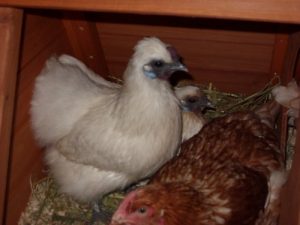 Shelter for Free Range Poultry
Shelter for Free Range Poultry
Land which is to support free-ranging chickens adequately must be sheltered. This does not refer to the obvious need for a house, but to factors such as the availability of trees, walls, windbreaks, shelters and hedges. The chicken originated in subtropical forests where trees provided cover and protection from wind, rain, sun and predators.
It is out of its natural environment in a wide open field, and tends to stay near the house. Consequently, the grass immediately around the house soon deteriorates, while that further afield is barely touched.
Although EU regulations demand that the stocking density does not exceed 1,000 birds to the hectare, the actual density in the limited area the birds tend to frequent is usually far higher than this, unless they are given positive encouragement to range further afield.
How Free Range Poultry Use Land
The Scottish Agricultural Colleges have conducted a survey to investigate the distribution of land usage and the number of birds going out onto range.
By plotting the location of birds at one-hourly intervals, they discovered that 55 per cent stayed in the area around the house, thereby using 8 per cent of the total area available. The mean distance of birds from the house was 8.3 m out of a possible 80 m..
Weather is obviously a factor which influences chickens in using the range, with warm, dry conditions being more conducive to ranging than wet, windy ones. Hot sun is not particularly liked, but warm, relatively shaded conditions are ideal, reminding them of their jungle origins. However, the shelter/security factor is not one that should be neglected. My own observations are that chickens will range much further afield if there are plenty of trees on the site.
Providing Shade for Free Range Poultry
Keeping chickens in an orchard proved to be the ideal, with a far more uniform distribution over the whole site than when I had them in an open field. If a site is properly fenced against foxes, the provision of trees is an excellent inducement to the chickens to range over the whole protected site.
Trees also provide much-needed shelter from wind, although any which are too near the perimeter fence may need to be cut back if they are likely to provide a launching pad for chickens to flutter over.
Other Shelters and Shade for Free Range Poultry
Trees are not the only form of shelter, of course. Wattle hurdles, hedges, banks, straw bales and stone walls all provide protection from the wind, as well as the feeling of security which is so necessary for chickens if they are to forage all over the available ground.
It is interesting to note that a free-range unit which was set up in an old three-acre walled garden experienced no problems in getting the chickens to range all over the site. There were several trees, and the high stone walls gave an overall feeling of enclosure.Moveable shelters with outside drinkers are recommended for use in hot weather. Such shelters need not be elaborate or expensive constructions, merely something that will provide shade from the hot sun and help to keep the water supply relatively cool. Registration with Freedom Food requires an overhead cover shelter for winter and summer conditions, as well as to reduce fear reactions from overhead predators.
On a small scale, a simple temporary shade shelter is easily made by banging some posts into the ground, placing wire netting on the top and covering it with black plastic weighted down with turf or a few leafy branches.
Extract from Free Range Poultry by Katie Thear
Widely recognised as the definitive guide to modern free-range poultry management, Free Range Poultry is a practical and comprehensive guide that is up to date with legislation and research findings. These articles on land management in free-range poultry systems are extracted from the book.
Further Articles on Free Range Poultry
- Fencing for Free Range Poultry – Free Range Poultry Fencing
- Flock Density Regulations for Free Range Poultry
- Free Range Poultry Land Management
- Nature of the Land for Free Range Poultry
- Paddock & Pasture Rotation for Free Range Poultry
- Paddock Management for Free Range Poultry
- Sheltered Areas for Free Range Poultry – Free Range Poultry Shelter

